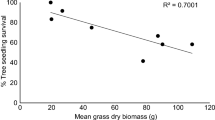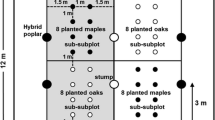Abstract
Acacia karroo Hayne is the most important woody invader of grassland in South Africa, and can greatly reduce the productivity of grassland. A field experiment was conducted to test the hypotheses that emergence, growth and the 1st year's survival of Acacia karroo would be enhanced by (1) defoliation of the grass sward, (2) increased irradiance, (3) increased moisture availability and (4) its germination within cattle dung pats. The study was conducted on one site above and one below the natural altitudinal treeline of this species in grassland of the eastern Cape, South Africa. Not one seedling emerged from dung pats. Neither location nor the other treatments affected the density of emerging seedlings, although only 40.4 seedlings m−2 emerged of the 200 seeds m−2 planted. Shading dramatically increased the density of surviving seedlings. In the open, only 3 and 1.5 seedlings m−2 remained respectively at the end of the growing season or the beginning of the next, compared to 23.3 and 19.5 seedlings m−2 under shading for these respective times. This was attributed to the effect of shade on moisture availability in a season which received only 54% of average rainfall. Seedling survival until the end of the growing season was enhanced (30%) by shade at both sites, but also by supplemental water (24%) and defoliation of the sward (7%) at the site above the treeline. Across sites and treatments, seedling survival was related to moisture availability, with no or poor survival for < 500 mm rainfall, indicating this species can only establish in certain rainfall years. Seedling survival over winter was not influenced by treatment, but was greater for larger seedlings. Treatments affected seedling size, in particular seedlings growing under shade and within a dense grass canopy were etiolated. A. karroo seedlings are capable of establishing and surviving within a dense grass sward for at least a year, tolerant of low irradiance and of interference, which, because most seeds do not persist for much longer than a year, suggests this species forms predominantly a seedling bank. This has implications for the invasion of grassland by woody species.
Similar content being viewed by others
References
Acocks JPH (1988) Veld types of South Africa. Mem Bot Soc S Afr 57
Adams TE, Sands PB, Weitkamp WH, McDougald NK (1992) Oak seedling establishment on California rangelands. J Range Manage 45: 93–98
Albertson FW, Weaver JE (1942) History of the native vegetation of western Kansas during seven years of continuous drought. Ecol Monogr 12: 25–51
Archer S, Scifres C, Bassham CR, Maggio R (1988) Autogenic succession in a subtropical savanna: rates, dynamics and processes in the conversion of a grassland to a thorn woodland. Ecol Monogr 52: 111–127
Arnold GW, Hill JL (1972) Chemical factors affecting selection of food plants by ruminants. In: Harborne JB (ed), Phytochemical ecology. Academic Press, London pp 71–101
Borchert MI, Davis FW, Michaelsen J, Oyler LD (1989) Interactions of factors affecting seedling recruitment of Blue Oak (Quercus douglasii) in California. Ecology 70: 389–404
Brown JR, Archer S (1989) Woody plant invasion of grasslands: establishment of honey mesquite (Prosopis glandulosa var. glandulosa) on sites differing in herbaceous biomass and grazing history. Oecologia 80: 19–26
Brown NAC, Booysen P de V (1967) Seed germination and seedling growth of two Acacia species under field conditions in grassveld. S Afr J Sci 10: 659–666
Bush JK, Van Auken OW (1990) Growth and survival of Prosopis glandulosa seedlings associated with shade and herbaceous competition. Bot Gaz 151: 234–239
Caldwell MM, Richards JH, Manwaring JH, Eissenstat DM (1987) Rapid shifts in phosphate acquisition show direct competition bewteen neighboring plants. Nature 327: 615–616
Caswell H (1989) Matrix population models. Sinauer, Sunderland
Chesterfield CJ, Parsons RF (1985) Regeneration of three tree species in arid south-eastern Australia. Aust J Bot 33: 715–732
Coe M, Coe C (1987) Large herbivores, acacia trees and bruchid beetles. S Afr J Sci 83: 624–635
Comins DM (1962) The vegetation of the districts of East London and King Williams Town, Cape Province. Mem Bot Surv S Afr 33
Cook RE (1979) Patterns of juvenile mortality and recruitment in plants. In: Solbrig OT, Jain S, Johnson GB, Raven RH (eds), Topics in plant population biology. Columbia University Press, New York pp 207–231
Cook SJ, Ratcliff D (1984) A study of the effects of root and shoot competition on the growth of green panic (Panicum maximum var. trichoglume) seedlings in an existing grassland using root exclusion tubes. J Appl Ecol 21: 971–982
Du Toit PF (1966) An autecological study of the Acacia karroo seedling. MSc thesis, University of Pretoria
Du Toit PF (1967) Bush encroachment with specific reference to Acacia karroo encroachment. Proc Grassld Soc Sthn Afr 2: 119–126
Ellison L (1960) The influence of grazing on plant succession. Bot Rev 26: 1–78
Fienberg S (1979) The analysis of cross-classified categorical data. MIT Press, Cambridge, Massachusetts
Friedel MH (1987) A preliminary investigation of woody plant increase in the western Transvaal and implications for veld assessment. J Grassld Soc Sthn Afr 4: 25–30
Gerhardt K (1993) Tree seedling development in tropical dry abandoned pasture and secondary forest in Costa Rica. J Veg Sci 4: 95–102
Gibbs Russell GE, Reid C, Van Rooyen J, Smook L (1985) List of species of southern African plants, 2nd edn, 2, part 1. Mem Bot Surv S Afr 51
Holland EA, Detling JK (1990) Plant response to herbivory and below ground nitrogen cycling. Ecology 71: 1040–1049
Janzen DH (1981) Enterolobium cyclocarpum seed passage rate and survival in horses, Costa Rican Pleistocene seed dispersal agents. Ecology 62: 593–601
Macvicar CN, Loxton RF, Lambrechts JJN, Roux J, Van Rooyen TH, Harmse HJ Von M (1977) Soil classification: a binomial system for South Africa. Department of Agriculture and Technical Services, Pretoria
Mahall BE, Schlesinger WH (1982) Effects of irradiance on growth, photosynthesis, and water use efficiency of seedlings of the chaparral shrub, Ceanothus megacarpus. Oecologia 54: 291–299
McPherson GR (1993) Effects of herbivory and herb interference on oak establishment in a semi-arid temperate savanna. J Veg Sci 4: 687–692
Milton SJ (1982) Effects of shading on nursery grown Acacia seedlings. J S Afr Bot 48: 245–272
Parker MA (1982) Association with mature plants protects seedlings from predation in an arid grassland shrub, Gutierrezia microcephala. Oecologia 53: 276–280
Ross JH (1971) Acacia karroo in southern Africa. Bothalia 10: 385–401
Ross JH (1979) A conspectus of the African Acacia species. Mem Bot Surv S Afr 44
SAS Institute (1988) SAS/STAT user's guide. SAS Institute, Cary
Scifres CJ, Kienart CR, Elrod DJ (1973) Honey mesquite seedling growth and 2,4,5,-T susceptibility as influenced by shading. J Range Manage 26: 58–60
Smith TM, Goddman PS (1987) Successional dynamics in an Acacia nilotica-Euclea divinorum savannah in southern Africa. J Ecol 75: 603–610
Smith TM, Shackleton SE (1988) The effects of shading on the establishment and growth of Acacia tortilis seedlings. S Afr J Bot 54: 375–379
Story R (1952) A botanical survey of the Keiskammahoek district. Mem Bot Surv S Afr 27
Stuart-Hill GC, Tainton NM (1989) The competitive interaction between Acacia karroo and the herbaceous layer and how this is influenced by defoliation. J Appl Ecol 26: 285–298
Ueckert DN, Smith LL, Allen BL (1979) Emergence and survival of honey mesquite seedlings on several soils in west Texas. J Range Manage 32: 284–287
Van Auken OW (1990) Size distribution patterns and potential population change of some dominant woody species of the Edwards plateau region of Texas. Texas J Sci 45: 199–210
Van Auken OW, Bush JK (1990) Influence of light levels, soil nutrients, and competition on seedling growth of Baccharis neglecta (Asteraceae). Bull Torrey Bot Club 117: 438–444
Van Vegten JA (1983) Thornbush invasion in a savanna ecosystem in eastern Botswana. Vegetatio 56: 3–7
Walker BH (1976) An approach to the monitoring of changes in the composition and utilization of woodland and savanna vegetation. S Afr J Wildl Res 6: 1–32
Walker BH, Ludwig D, Holling C, Peterman RM (1981) Stability of semi-arid savanna grazing systems. J Ecol 69: 473–498
Welker JM, Menke JW (1990) The influence of simulated browsing on tissue water relations, growth and survival of Quercus douglasii (Hook and Arn.) seedlings under slow and rapid rates of soil drought. Funct Ecol 4: 807–817
Woodell SRJ (1990) Regeneration in the shrub Acacia burkittii FvM. ex Benth. in the arid zone of South Australia. Biol Cons 51: 39–48
Author information
Authors and Affiliations
Rights and permissions
About this article
Cite this article
O'Connor, T.G. Acacia karroo invasion of grassland: environmental and biotic effects influencing seedling emergence and establishment. Oecologia 103, 214–223 (1995). https://doi.org/10.1007/BF00329083
Received:
Accepted:
Issue Date:
DOI: https://doi.org/10.1007/BF00329083




